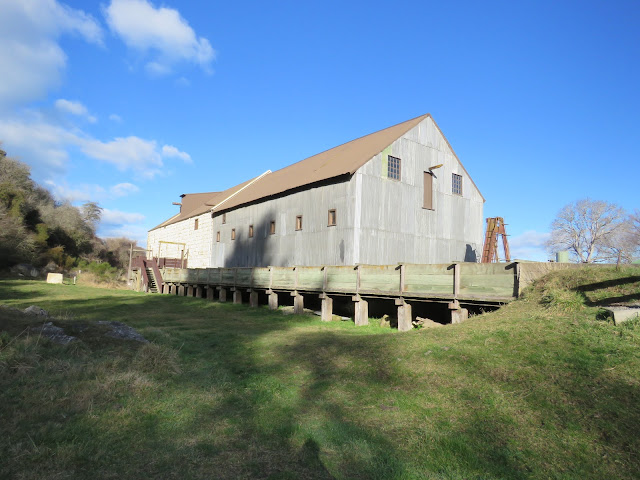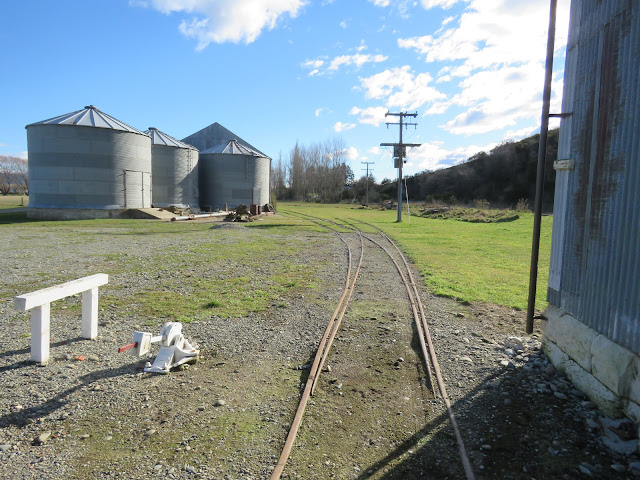
Maheno Valley Mills (Clarks Mill) 1880s. Culture Waitaki Online Collection
Clarks Flour Mill is located on State Highway One between Maheno and Reidston. I've driven past this place countless times but it wasn't until last week I decided to stop by and have a look around.

Clarks Mill. Date unknown. Hocken Library.
Wheat growing and flour milling was once a very important part of the North Otago economy. One of 13 flour mills in the district, the original mill was built 1866 to a Scottish design using locally sourced limestone. The mill was connected to the Main South Line with a siding in 1877.
Originally water was drawn from Mill Stream and diverted through a water race which drove a water wheel. The water wheel powered the British machinery and French millstones to produce the flour.
A display of Snow Wreath Flour at the Clarks Milling Stand at the Oamaru Expo. Unknown Date. Hocken Library.From 1877 when the mill was connected the Main South Line a lot of traffic was generated from the mill which received local grain and dispatched flour. The mill was served by a siding that left the main line between the current State Highway One railway crossing and the Mill Creek railway bridge.
Signalling and Interlocking Arrangement Diagram for Maheno and Clarks Mill Siding. New Zealand Archives Dunedin Office.
I'm not sure how the siding was operated and whether New Zealand Railways locomotives worked the entire siding but for many years the siding was worked by a New Zealand Army surplus Bren Gun Carrier purchased by the mill after the second world war.
The Bren Gun Carrier at Clarks Mill. 1946. Culture Waitaki Online Collection.
My understanding is that the Bren gun carrier shunted the sidings and left wagons or picked up wagons on the siding directly beside the mainline and that NZR locomotives didn't actually fully work the sidings.
Clarks Mill outlasted most of the other flour mills in North Otago and closed in 1976.
So what's left at the Clarks Mill site today?
First I stopped at the railway level crossing on State Highway One just north of Maheno. The level crossing is just to the south of where the siding for the mill left the Main South Line. I remember reading somewhere that this level crossing is the only remaining level crossing on State Highway One that has no barrier arms but I'm not sure how accurate this is.
The State Highway One railway level crossing looking south towards Maheno. 09/07/21.
Looking north from the level crossing you can see a raised area to the right of the mainline where the siding started and where the siding descended on a right hand curve down towards the mill.
Site of the points off the main line leading to the mill siding. The siding split off the mainline and curved to the right towards the mill which can be seen in the middle right. Photo taken from the State Highway One level crossing. 09/07/21.
The entrance to the mill is well signposted and is on the right hand side of State Highway One as you head north from the level crossing.
Entrance to Clarks Mill off State Highway One.
The mill is looked after by Pouhere Taonga Heritage New Zealand and is a nationally recognised historic site. On my visit the mill was closed but you can still drive into the site and explore from the outside.
Leaving State Highway One the gravel road goes beneath the well known Mill Stream Bridge number 167.
Mill Stream Bridge. 09/07/21.
Bridge 167 Mill Stream Bridge Kiwirail Information Sign.
The first building you come to is the old weighbridge and cabin. The weighbridge consists of the weighbridge itself with a small timber and corrugated iron lean to cabin directly to the north. Unfortunately the cabin was locked so I wasn't able to get a good picture of the interior.
Clarks Mill weighbridge and cabin facing east. 09/07/21.
Clarks Mill weighbridge and cabin facing west with the Mill Stream railway bridge in the background. 09/07/21.
The rear of the Clarks Mill weighbridge and cabin facing east. 09/07/21.
Clarks Mill weighbridge facing west. You can see the old track alignment heading straight before curving up to the left towards the main line. 09/07/21.
Clarks Mill weighbridge facing east showing the old track alignment towards the mill. 09/07/21.
After having a good look around the weighbridge I made my way over to main mill area.
The mill area consists of three main buildings. A large corrugated iron store, the main milling building and a workers residence.
The first one I had a look around was the large flour store. The store is now used by the North Otago Vintage Machinery Club.
Clarks Mill Flour Store north side. 09/07/21.
Clarks Mill Flour Store north side. 09/07/21.
I don't know why but I'm always fascinated by large industrial buildings like this and this one has it all. Its a large corrugated iron store with a railway siding on the north side. Looking at the aerial photo near the top of this post shows a large store to the north of the railway siding. I'm not sure if the current building was the old one that was moved to the current position or if the old building was demolished and this one built to the south of the siding.
Detail shot of the Clarks Mill Flour Store north side. 09/07/21.
At the eastern end of the shed is three silos. All the associated augers and pipe work is now gone but some of it remains on the ground near the silos.
Clarks Mill Flour Store including the three silos on the eastern side. 09/07/21.
The railway siding alongside the Flour Store. 09/07/21.
Along the north side of the flour store is the railway siding. Its here that the remains of loop exist. The siding itself curves around the north side of the store allowing access to two sliding doors that allowed wagons to be loaded directly from the store.
Concrete work on the railway siding beside the silos at the eastern end of the flour store. 09/07/21.
Concrete work can be seen between the silos and the railway siding. I'm not sure what this concrete work was for but parts of an auger lay nearby that was possibly used to load grain into or unload grain from wagons.
The old mill building to the east of the flour store with the railway siding at the centre. 09/07/21.
To the east of the flour store is the old mill building. This building is a combination of a corrugated iron store and a four storey building built to a Scottish design using locally quarried lime stone.
The old mill building. 09/07/21.
Along the north side of the old mill building is a concrete water race where diverted water from Mill Stream was channeled to a large water wheel to drive the milling machinery and millstones.
The concrete water race coming from Mill Stream. 09/07/21.
The water race leading to the mill. 09/07/21.
The timber water race along the north side of the old mill building. 09/07/21.
A detail shot of the timber water race along the north side of the old mill building. 09/07/21.
A detail shot of the timber water race along the north side of the old mill building. 09/07/21.
A detail shot of the timber water race along the north side of the old mill building. 09/07/21.
Returning to the south side of the building you can see the end of the railway siding which is alongside the south side of the mill building.
Western end of the old mill building. 09/07/21.
Southern side of the old mill building. 09/07/21.
Southern side of the old mill building. 09/07/21.
The siding loop ends at the old mill building and the loop points and trackwork remain in place.
The eastern end of the siding loop. 09/07/21.
The siding loop point leading to the old mill and the end of the siding. 09/07/21.
A points lever has been placed beside the loop point but is not connected to the points. Looking at the photo of the Bren Gun Carrier earlier in this post it isn't the same one. While not the original lever for the siding it's still a good find with its cast lever weight having NZR 1882 on it.
The point lever for the loop points at the old mill. 09/07/21.
Just to the east of the points sits an old La class 4 wheel high side wagon. These wagons would have been a common sight on this siding loaded up with bagged grain. This wagon has been refurbished and has the number LA 1360 stenciled on the frame.
Four wheel high side wagon LA 1360 at Clarks Mill. 09/07/21.

Side on view of LA 1360. 09/07/21.
End view of LA 1360. 09/07/21.
Detail shot of the suspension, bearings and wheel on LA 1360. 09/07/21.
Just to the side of the wagon is a lean to shelter and a door where grain and flour was loaded into wagons. The lean to shelter is also where the siding ends.
The lean to shelter and end of the siding at the old mill building. 09/07/21.
End of the line. The end of the siding beneath the lean to shelter. 09/07/21.
Off to the side of the old mill building is a weatherworn timber office and store. This building has seen better days.
Old office and store. 09/07/21.
Having to get back on the road I was able to have a quick look at the millers residence and cottage on the site. These buildings have been well looked after and provide some good examples of North Otago building construction when timber was in short supply but there was plenty of lime stone available.
The millers residence and cottage. 09/07/21.
The mill is open for visitors between September and May on Thursdays 10:30am to 1pm and on Sundays 1pm to 3pm. Costs are $10 for adults, $5 for tertiary students and children are free.
The mill machinery runs on the last Sunday of the month. The cost for adults increases to $15 when the machinery is operating.
Well done to Pouhere Taonga Heritage New Zealand and the local volunteers that maintain this site and keep New Zealand's early industrial history alive for future generations. I for one will be back in the summer to see the mill in operation.
If you want to know more about Clarks Mill please visit the Pouhere Taonga Heritage New Zealand's Clark Mill page.
And that's about it.











































No comments:
Post a Comment